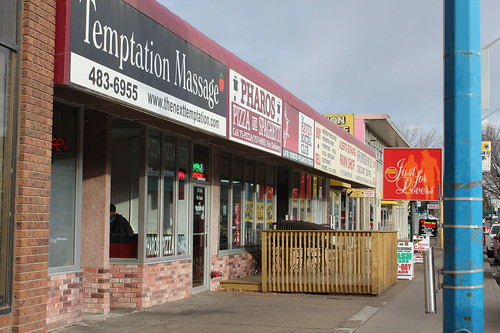How sex work has changed in Edmonton’s west end
By Shaamini Yogaretnam
EDMONTON — A look tells Kari Thomason who is in the business of selling sex. She sees a woman sitting on a bench along Stony Plain Road, and she just knows.

Temptation Massage, located at 15122 Stony Plain Rd., is one massage parlour that the new body-rub-centre bylaw amendments will affect. The parlour is on a road where traditional prostitution is a community mainstay, but provides services that will be licensed and regulated as of Jan. 1, 2012. These services are changing the definition of sex work in Edmonton. Thursday, Nov. 10, 2011. Photograph by Shaamini Yogaretnam.
“She’s looking for a date,” says Thomason on a cool night earlier this fall as she drives across the city “tracking,” or checking in on sex workers for Project SNUG, an outreach program she co-ordinates.
How does she know?
“It’s called ‘spyhopping,’ ” says Thomason.
It’s a term borrowed from the study of whales, who poke their heads out of the water to gauge their surroundings before emerging fully. For girls on the street, spyhopping means the kind of eye contact they make as they search for a man who might want to pay them for sex.
Communication for the purpose of prostitution is a crime, but a look is harder to book. The prostitutes and johns know it when they see it, and so does the social worker Thomason.
More and more, sex workers are getting around the law in another way: by working in erotic massage parlours, where dates are arranged by appointment instead of eye contact. New regulations that differentiate between therapeutic massage parlours and “rub-and-tugs” are a signal of the changing face of sex work in Edmonton.
Massage parlours
Changes to the city’s massage parlour bylaw were passed by city council in late September and will come into effect on Jan. 1. Parlours will be classified, and thereby licensed, as either a health enhancement centre, which would cover registered massage therapy, or as a body rub centre, which would define erotic massage, or those centres commonly known as “rub-and-tugs.”
The changes also demand higher licensing fees for body rub centres, a mandatory sexual exploitation class for business owners, and proof that all employees are over 18. Under the current bylaw, the fee for all massage practitioners is $76. Body rub centres would see that fee increase to $208 in the new year, while health enhancement parlours would pay $80.
City council’s decision to make these changes reflects the large number of erotic massage parlours in Edmonton. City estimates have put the number of parlours that would need body-rub licensing in Edmonton at over 40. That makes Edmonton unusual, Thomason says.
“We have 48 rub-and-tugs,” she says. “Calgary has six.”
Visible and accepted
The area of Stony Plain Road between 149 Street and 163 Street has both erotic massage parlours and the more traditional street prostitution. Const. James Shaw recognizes that in parts of his beat, prostitution is so visible that it’s accepted.
“It would be very rare that we’ll see a call on the board for someone reporting someone prostituting or being concerned about someone, because it’s a daily thing here,” Shaw says. “It’s more us generating those calls ourselves.”
The majority of the outreach done by Project SNUG is aimed towards women who continue to work on the streets. These women have different reasons for sex work — often a need to feed a drug addiction — and face different challenges from women who work in the parlours.
Typically, body rub massage parlours are closed by 11:30 p.m. and try not to stick out on a busy avenue. They specialize in the “girlfriend experience” and target different clients than traditional prostitution does, says Shaw.
High track vs. low track
The city’s initial move to allow erotic massage parlours years ago was an effort to deal with the issues of addiction and violence commonly seen on the street.
“The city decided to establish ‘rub-and-tugs’ because we used to have a high track and a low track,” Thomason says. “Not anymore, we’re completely low-track now.”
The high- and low-track divide in Edmonton was actually marked by the track where the LRT comes up from the underground between Churchill Station and Stadium, off of 95 Street.
“From the train tracks south was all high track — girls who were expensive and controlled by pimps,” Thomason says. “North of the bridge were girls considered low-track, gang-run, and independent girls.”
Once the city’s licensing came in, the high-track women moved inside, and those working on the low track moved to the high-track positions, hoping for better treatment and more security. Yet the challenges faced by each group remained with them, even though they were doing different work.
While Thomason doesn’t believe that the high track still exists in Edmonton, there is a difference in the type of sex work seen throughout the city. Escort services and massage parlours in other neighbourhoods, mainly those downtown, certainly attract a different kind of sex worker and client, Shaw says. The west end, despite the number of massage parlours, still experiences high levels of exploitation and addiction.
The acceptance of some forms of prostitution in the area allows a service like SNUG to work, and for people like Thomason to keep in touch with the women working in the area.
The changes to the bylaw worry Thomason, however, in that further regulation might lead to a new low track and high track, with high-end parlours that can afford the additional fees and treat their employees reasonably well, and low-end parlours that go underground, leaving the women who work there without any regulatory protection.











